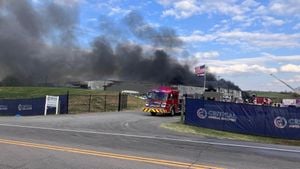Manufacturing is experiencing a significant resurgence across the United States, especially among small urban areas, marking the first full recovery from recession losses since the 1970s. After the disruptions wrought by the COVID-19 pandemic, areas like McLean County, Illinois, are witnessing remarkable growth in factory jobs, transforming local economies and revitalizing communities.
Traditionally known for the insurance giant State Farm and Illinois State University, McLean County is now making headlines for its booming manufacturing sector. Electric vehicle manufacturer Rivian has expanded dramatically, ramping up its workforce from about 300 employees to 8,000. Patrick Hoban, president of the Bloomington-Normal Economic Development Council, notes this astonishing shift: “Food and electric cars. This is not something we were known for before 2019.” Not only has Rivian surged, but the area is also welcoming new ventures such as candy manufacturing, adding to the job market.
According to the Economic Innovation Group, the recovery of manufacturing jobs has mirrored broader trends across the country. By 2023, the U.S. boasted approximately 12.9 million manufacturing jobs, surpassing pre-pandemic figures and representing the first comprehensive recovery since the recession of the late '70s. This rebound reveals how factories are migrating to smaller towns where living costs are lower.
Throughout this period of recovery, several states have benefitted more than others. States like Nevada, Utah, and Florida have seen significant increases, with Nevada's manufacturing job growth at 14%, boosted by companies like Tesla and other related industries. The narrative is clearer: small towns are becoming the new epicenters of manufacturing activity.
Joseph McCartin, a Georgetown University professor specializing in labor history, highlights the importance of federal legislation like the CHIPS and Science Act, which aims to increase job opportunities and wages within these sectors. Post-pandemic, the Biden administration initiated policies to support union jobs and uplift wage standards. McCartin asserts, “The Biden administration tried to use policy to encourage more of these jobs to be union or at least union-level wages.” Nevertheless, this goal is now uncertain due to political shifts following recent elections.
The sustained growth of manufacturing jobs, particularly post-pandemic, adds complexity to the existing labor market. Experts caution, as highlighted by University of Minnesota professor William Jones, about the potential challenges of job placement if immigration policies tighten under the new administration. Jobs such as meat processing, typically filled by immigrants, could face severe shortages if proposed deportation plans come to fruition.
The geographic distribution of new manufacturing roles is telling. Small cities have surged forward, gaining ground where larger metropolitan areas or rural locales have stalled. The most significant job increases occurred predominantly within the Sun Belt states. For example, Texas added over 48,000 manufacturing jobs, highlighting the growth as manufacturers seek favorable conditions such as lower living costs and regulatory environments.
States like Alabama have also become hotspots for automotive production. Manufacturing facilities have mushroomed there, with Mazda Toyota Manufacturing hiring thousands near the Tennessee border. This shift is backed by substantial investment, totaling around $7 billion. Yet the history of unionization poses challenges; Republican leaders have advanced legislation to stifle union growth, fearing it will upset the burgeoning manufacturing economy.
The automotive industry stands out, boasting considerable job creation thanks to both resurgence and new plants. While cities like Detroit have long been synonymous with manufacturing, today’s growth often bypasses traditional industrial hubs. Instead, smaller locales are gaining traction, illustrating how geographic and economic landscapes are shifting. For example, the increased jobs within areas like Storey County, Nevada, show rapid expansion where the total number of jobs grew from under 4,000 to around 16,000 due to manufacturing and other sectors. Steve Scheetz, research manager for the Nevada Governor's Office of Economic Development, noted how even lesser-known places are now thriving economically.
Industry experts agree on the role economic factors have played. The pandemic highlighted significant advantages of domestically produced goods, pushing manufacturing's regeneration. “Supply-chain problems during the pandemic illustrated the advantages of American-made goods,” said McCartin. Even with the increase, the resilience of lower-cost labor overseas continues to dampen wages and prospects for sustained growth.
The rising need for factory jobs is apparent as many states seek to balance their economies, especially with low-wage service jobs proliferated due to the pandemic. Presently, manufacturing jobs still rank among the higher-paying blue-collar fields, averaging around $34.42 per hour, significantly more than many service industry roles.
Despite the positive trend, the decreased union power lowers opportunities for workers to attain the same middle-class lifestyle their predecessors once enjoyed. Recent developments have seen various measures taken by state Republican leaders to push back against unionization efforts, particularly as Southern states grapple with ascending labor movements aiming for higher pay and conditions. For example, Alabama Governor Kay Ivey's recent law aims to retract state incentives from companies acknowledging unions.
Looking forward, much remains uncertain as political landscapes continue to evolve. The Biden administration’s efforts to spark economic growth, particularly within small cities, highlight significant changes and challenges. Even with the triumphs noted at plants like Rivian, experts maintain skepticism over manufacturing alone resolving the broader challenges facing the American working class.
Overall, the picture of America’s manufacturing is complex and continues to shift dramatically across state lines and city boundaries. The transformation points to shifting economic paradigms geared not only toward recovery but toward sustainability and growth within smaller communities. The focus on manufacturing jobs is more than just numbers; it’s about shimmering opportunities for individuals aiming for promising futures.
It’s clear the focus has turned to these new economic hubs, perhaps signifying a return to form for the American manufacturing ethos. While the road ahead holds many uncertainties, the data currently suggests these small towns, often overshadowed by their larger urban counterparts, are positioning themselves at the forefront of America's manufacturing renaissance.



